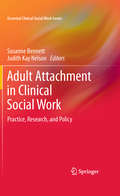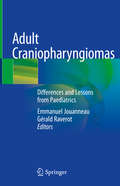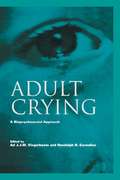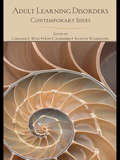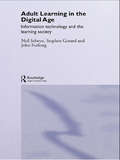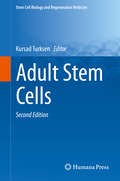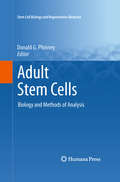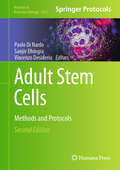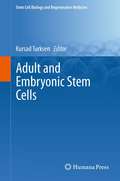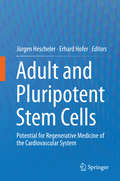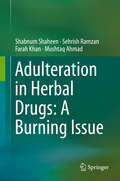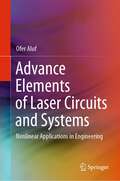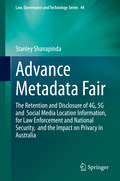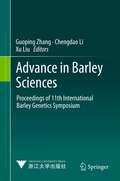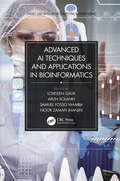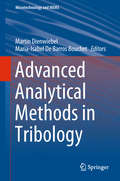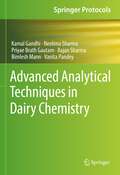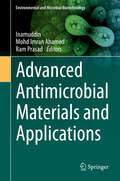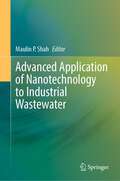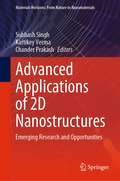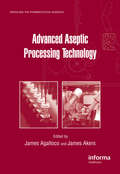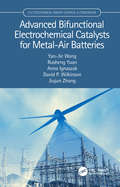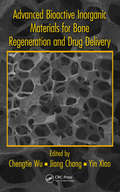- Table View
- List View
Adult Attachment in Clinical Social Work: Practice, Research, and Policy (Essential Clinical Social Work Series)
by Judith Kay Nelson Susanne BennettThe applicability of attachment theory and research to social work and social policy relating to infants and children is well-established. Yet, its usefulness for enhancing the understanding of adults and their needs, both individually and as a group, has been less featured in the attachment literature. Adult Attachment in Clinical Social Work Practice is a wide-ranging look at attachment theory and research, its application to adults, and its natural fit with the social work profession. This edited volume covers the applicability of adult attachment theory to the clinical social work profession's various domains that include human behavior, practice, policy, research, and social work education. It addresses the broad spectrum of clinical social work, including practice in a variety of public and private settings and with a number of diverse populations, including racial-ethnic groups, gays and lesbians, trauma survivors, and child welfare parents. The book highlights the underemphasized contribution of the social work profession to the development of attachment theory and research.
Adult Continuing Education and High School Course Catalog
by Hadley Institute for the Blind Visually ImpairedAdult Continuing Education and High School Course Catalog 2016-2017. Catalog of current distance education courses for the blind or visually impaired. Various media for the courses is available including; Braille, CD, Digital Talking Books, Large Print, Online and more. Not all courses are available in all formats.
Adult Craniopharyngiomas: Differences and Lessons from Paediatrics
by Emmanuel Jouanneau Gérald RaverotThis volume focuses on adult craniopharyngiomas, offering various perspectives. The first part of the book provides an up-to-date overview of the pathogenesis and management of adult craniopharyngiomas, helping readers understand the pathogenesis and molecular pathways. It highlights the importance of animal models for addressing molecular keys and for developing targeted therapies. The second part deals with clinical management, detailing the latest results in the era of endoscopic surgery, including the major contribution of the extended nasal endoscopic approaches for suprasellar and retrochiasmatic tumors. The book also discusses the key aspects of these tumors and how to manage them. The last part of the book addresses the future therapies and recurrences after surgery and radiotherapy. This volume is of interest to neurosurgeons, endocrinologists, paediatricians, radiologists and oncologists.
Adult Crying: A Biopsychosocial Approach
by Ad J.J.M. Vingerhoets Randolph R. CorneliusCrying is a typical human expression of emotion. Surprisingly, until now little scientific attention has been devoted to this phenomenon. Many textbooks on emotion fail to pay attention to it, and in scientific journals there are hardly any contributions focusing on this behavior. In contrast, there is much interest from the lay public, allowing pseudo-scientists to formulate theories that have little or no scientific basis. Is there any evidence in support of statements that crying is healthy or that not crying may result in toxification? How do people react to the crying of others? Is crying important for the diagnosis of depression, and if so, how? This book aims to fill this gap in scientific literature. Crying is discussed from several perspectives and specific attention is given to methodological issues and assessment. Each chapter provides a review and a summary of the relevant scientific literature.
Adult Learning Disorders: Contemporary Issues
by Lorraine E. WolfRecent advances in neuroimaging and genetics technologies have enhanced our understanding of neurodevelopmental disorders in adults. The authors in this volume not only discuss such advances as they apply to adults with learning disorders, but also address their translation into clinical practice. One cluster of chapters addresses developmental concerns as children and adolescents with learning disorders approach young adulthood. Experts discuss dyslexia, language-based and writing disorders, perhaps the most widely studied group of learning disorders, from the point of view of neuroimaging and genetic underpinnings. Chapters on the neuroscience of nonverbal, math and executive function disorders are also included. Clinically-oriented chapters with case studies, recommendations for accommodation, and considerations for evaluation follow. Study of specialized populations - such as late high school students, college, medical and law students - further demonstrate how our expanded knowledge base may be applicable to clinical practice. The heterogeneity of adults with learning disorders, the complexity of their clinical presentation and co-existing disorders are addressed from both a scientific and clinical point of view demonstrating how empirical research and clinical practice inform each other. This volume will enhance the practice of clinicians and educators working with adults with neurodevelopmental disorders, as well as providing essential current information for researchers of adults with learning disorders.
Adult Learning in the Digital Age: Information Technology and the Learning Society
by John Furlong Stephen Gorard Neil SelwynThis engaging book sheds light on the ways in which adults in the twenty-first century interact with technology in different learning environments. Based on one of the first large-scale academic research projects in this area, the authors present their findings and offer practical recommendations for the use of new technology in a learning society. They invite debate on: why ICTs are believed to be capable of affecting positive change in adult learning the drawbacks and limits of ICT in adult education what makes a lifelong learner the wider social, economic, cultural and political realities of the information age and the learning society. Adult Learning addresses key questions and provides a sound empirical foundation to the existing debate, highlighting the complex realities of the learning society and e-learning rhetoric. It tells the story of those who are excluded from the learning society, and offers a set of strong recommendations for practitioners, policy-makers, and politicians, as well as researchers and students.
Adult Stem Cells (Stem Cell Biology and Regenerative Medicine)
by Kursad TurksenAdult Stem Cells, second edition, takes a critical look at issues concerning the developmental or differentiation potential for a variety of tissue types and for specific adult stem cell types. Since the first edition appeared a decade ago, our understanding of adult stem cells, and more specifically tissue-specific adult stem cells, has advanced tremendously. And an increased interest in regenerative medicine and potential stem cell applications has driven a quest for better understanding of stem cell biology. In turn, this has spawned much activity on generation and utilization of more and better reagents to identify and isolate stem cells and stem cell-like subpopulations, and on assays elucidating their developmental or differentiation potential and functional integration with host tissues and organs. In this fully updated new edition, chapters cover topics ranging from signaling pathways maintaining stemness in hematopoietic cells to regeneration after injury and endocrine mechanisms underlying the stem cell theory of aging. Other chapters cover stem cells by organ or system including pituitary, cardiac, epithelial, teeth, lung, ovary, prostate, liver, and many more. Importantly, the authors of the chapters have not only summarized their successes, but have also summarized some of the difficulties that each particular field is still facing with respect to maximizing the utility of stem cells in clinical settings. Collectively, they impart both the excitement and challenges facing stem cell utilization for repair and regeneration making this book essential reading for those involved in stem cell research as well as those involved in clinical assays.
Adult Stem Cells: Biology and Methods of Analysis (Stem Cell Biology and Regenerative Medicine)
by Donald G. PhinneyThis is comprehensive overview of a vital area of scientific enquiry, which covers a broad spectrum of issues. With contributions from some of the key researchers in the field, Adult Stem Cells: Biology and Methods of Analysis offers readers a historical perspective as well as unique insights into cutting-edge thoughts. The volume contextualizes the recent discovery of stem/progenitor cell populations resident in many adult tissues and organs. It confronts the complexities scientists face in trying to validate these cells, while it also describes and critically evaluates the methods currently used to assess stem cell self-renewal. The chapters also seek to distinguish this process from other aspects of cell survival, such as the regulation of life span, senescence, and immortalization at a molecular level. The monograph begins with a section that examine the basic biology of adult stem cells, including chapters on the emerging role of microRNAs in regulating their fate and the molecular mechanisms that govern their self-renewal, the book moves on to analyze the varying methodologies employed in characterizing these elusive elements of our genetic make-up. The second section details in-vivo lineage tracing of tissue-specific stem cells, explores the neural stem cell paradigm, and considers the function of ABC transporters and aldehyde dehydrogenase in adult stem-cell biology. The final section shifts the focus to the life-span regulation and immortalization and features a chapter on the cancer stem cell paradigm. This is an authoritative volume on one of the frontiers of genetic research, and will serve as a valuable resource, not just for established scientists but also for those now entering the field of stem cell biology.
Adult Stem Cells: Methods and Protocols (Methods in Molecular Biology #2835)
by Paolo Di Nardo Sanjiv Dhingra Vincenzo DesiderioThis second edition volume expands on the previous edition with updated chapters covering a broader range of tissues and techniques pertaining to stem cell technologies. The chapters also cover topics such as the generation of iPSC-derived cells unique to the individual human genome addressing the possibility of more personalized clinical applications to an individual with a specific degenerative disease; and the use of nanoparticles such as 3D scaffolds and biomaterials as a means of improving stem cell viability after transplantation in the host tissue. Written in the highly successful Methods in Molecular Biology series format, chapters include introductions to their respective topics, lists of the necessary materials and reagents, step-by-step, readily reproducible laboratory protocols, and tips on troubleshooting and avoiding known pitfalls. Cutting-edge and authoritative, Adult Stem Cells: Methods and Protocols, Second Edition introduces insights into personalized medicine in stem cell therapies, and will spark new and innovative procedures relevant to stem cell therapy and tissue engineering.
Adult and Embryonic Stem Cells (Stem Cell Biology and Regenerative Medicine)
by Kursad TurksenThis volume will cover a series of reviews on stem cells including adult and embryonic stem cells. Speakers were invited to present these talks during the Stem Cell Symposia in fall of 2010, in Samsun, Turkey. Unique aspect of this volume is that it brings a multidisciplinary aspect of stem cells extracted from a symposium.
Adult and Pluripotent Stem Cells: Potential for Regenerative Medicine of the Cardiovascular System
by Jürgen Hescheler Erhard HoferThere is hardly an area of research developing so quickly and raising so many promises as stem cell research. Adult, embryonic and recently available induced pluripotent stem cells not only foster our understanding of differentiation of endo-, ecto- and mesodermal lineages to all organs of the body, but foremost nourish the hope that cells grown in culture can be used for regeneration of diseased organs such as the heart damaged by myocardial infarction. This book focuses on perspectives of stem cells for regenerative therapy of cardiovascular diseases. Based on the EC consortium INELPY, it reviews the field and disseminates major outcomes of this project. Thus it introduces the reader to this fascinating area of research and incorporates very recent findings interesting to the expert, spanning the field from bench to bedside. The compilation of contributions is unique as there is yet no similar comprehensive overview combining stem cell research with preclinical and clinical evaluation as well as engineering of tissue patches for transplantation. As such it will be an invaluable source of information for all researchers in the stem cell and tissue regeneration field including bioengineers as well as for all clinicians interested in regenerative therapies, especially for ischemic cardiomyopathies.
Adulteration in Herbal Drugs: A Burning Issue
by Mushtaq Ahmad Shabnum Shaheen Sehrish Ramzan Farah KhanSubstitution and adulteration in traded herbal raw material are common practice in the herbal industry due to the extinction of required species, deforestation and incorrect taxonomical identification. Herbalists have adopted methods to create high quality adulteration which cannot be detected without performing microscopic examination or chemical analysis. It is difficult to establish specific quality control standards due to the complex nature and innate unpredictability of the chemical constituents of medicinal herbs.The main parameters for measurement and adulteration prevention in medicinal herbs are morphological and microscopic investigation, chemical profiling and DNA barcoding. The need for highly sensitive and more effective approaches for the authentication of medicinal herbs is necessary in order to promote the acceptance of herbal products. Adulteration In Traditional Medicinal Herbs is aimed at promoting awareness of adulteration in traditional herbal medicines for the worldwide scientific community. Parameters are established for the prevention of adulteration through classical and modern scientific tools. Valuable case studies are presented based on ethno-medicinal surveys performed in many herbal markets in Pakistan. Collections of various samples were obtained from these shops then compared with the original plants collected from field. Various phytochemical, organoleptic and DNA barcoding techniques were used in order to detect adulteration in the marketed herbal samples. This book is the first of its kind and is aimed at helping the scientific community to identify particular medicinal plants which are facing adulteration problems in herbal markets and to estimate the extent of adulteration and substitution in commonly used medicinal herbs.
Advance Elements of Laser Circuits and Systems: Nonlinear Applications in Engineering
by Ofer AlufThis book on Advance Elements of Laser circuits and systems Nonlinearity applications in engineering addresses two separate engineering and scientific areas, and presents advanced analysis methods for Laser circuits and systems that cover a broad range of engineering and scientific applications. The book analyzed Laser circuits and systems as linear and nonlinear dynamical systems and there limit cycles, bifurcation, and limit cycle stability by using nonlinear dynamic theory. Further, it discussed a broad range of bifurcations related to Laser systems and circuits, starting from laser system differential equations and their bifurcations, delay differential equations (DDEs) are a function of time delays, delay dependent parameters, followed by phase plane analysis, limit cycles and their bifurcations, chaos, iterated maps, period doubling. It combines graphical information with analytical analysis to effectively study the local stability of Laser systems models involving delay dependent parameters. Specifically, the stability of a given steady state is determined by the graphs of some functions of which can be expressed explicitly. The Laser circuits and systems are Laser diode circuits, MRI system Laser diode circuitry, Electron-photon exchanges into VCSEL, Ti: Sapphire laser systems, Ion channel and long-wavelength lasers, Solid state lasers, Solid state laser controlled by semiconductor devices, microchip solid-state laser, Q-switched diode-pumped solid-state laser, Nd:YAG, Mid-Infrared and Q-switched microchip lasers, Gas laser systems, copper vapor laser (CVL) circuitry, Dual-wavelength laser systems, Dual-wavelength operation of a Ti:sapphire laser, Diode-pumped Q-switched Nd:YVO4 yellow laser, Asymmetric dual quantum well lasers, Tm3+-doped silica fibre lasers, Terahertz dual-wavelength quantum cascade laser. The Book address also the additional areas, Laser X guiding system, Plasma diagnostics, Laser Beam shaping, Jitter and crosstalk, Plasma mirror systems, and High power Laser/Target diagnostic system optical elements. The book is unique in its emphasis on practical and innovative engineering and scientific applications. All conceptual Laser circuits are innovative and can be broadly implemented in many engineering applications. The dynamics of Laser circuits and systems provides several ways to use them in a variety of applications covering wide areas. This book is aimed at electrical and electronics engineers, students and researchers in physics as well. It is also aimed for research institutes in lasers and plasma physics and gives good comprehensive in laser and plasma systems. In each chapter, the concept is developed from basic assumptions up to the final engineering and scientific outcomes. The scientific background is explained at basic and advance levels and closely integrated with mathematical theory. Many examples are presented in this book and it is also ideal for intermediate level courses at graduate level studies. It is also ideal for engineer who has not had formal instruction in nonlinear dynamics, but who now desires to fill the gap between innovative Laser circuits/systems and advance mathematical analysis methods.
Advance Metadata Fair: The Retention and Disclosure of 4G, 5G and Social Media Location Information, for Law Enforcement and National Security, and the Impact on Privacy in Australia (Law, Governance and Technology Series #44)
by Stanley ShanapindaThis book outlines the legal powers of a major Western nation – Australia – to collect and use location information. Mobile service and social media service providers now have the ability to track, record and store more precise location information. Unlike 4G, 5G mobile communications require that cell towers and antennas be in much closer proximity; as a result, the location data can reveal more personal and sensitive information about individual citizens. Despite this aspect, service providers are required to disclose the data to the authorities, without the need for a judicial warrant. This book was written from the perspective of big location data software analytics, a capability that makes it possible to combine various location data points to create a profile on a given individual’s movements, habits, and political, religious and ideological orientation. In this regard, privacy is poorly protected. The rationale used to justify the powers was enforcing serious crimes – terrorism offences. Location data can now be retained for at least two years and be collected to investigate even minor offences. This can be done without the person being reasonably suspected of a criminal offence – when the individual is simply determined to be a person of interest. This poses legal risks to vulnerable communities. And yet, such investigative techniques are deemed lawful and reasonable. At a time when national security is so broadly defined to include economic issues, which in turn overlap with climate change and environmental protection, these legal powers should be reassessed. The book clarifies the complex rules that every citizen must know in order to have agency. Further, it calls upon authorities to reflect and to self-regulate, by making the conscious decision to surrender some of their powers to review by the independent judiciary. Without the requirement for a judicial warrant or judicial review, the powers are unfairly broad. The book pursues an interdisciplinary approach to assess the functionality of mobile telecommunications in direct relation to law enforcement powers and existing judicial precedents. Further, it offers a unifying techno-legal perspective on a complex issue touching on modern privacy law and communications technologies.
Advance in Barley Sciences: Proceedings of 11th International Barley Genetics Symposium (Advanced Topics In Science And Technology In China Ser.)
by Chengdao Li Guoping Zhang Xu LiuAdvance in barley sciences presents the latest developments in barley sciences. It collects 39 papers submitted to the 11th International Barley Genetics Symposium, and covers all presentation sessions of the conference, i.e., barley development and economy, utilization of germplasm, genetic resources and genetic stocks, end-uses, biotic stress tolerance, abiotic stresses, new and renewed breeding methodology, barley physiology, breeding success stories, barley genomics and all other '-omics.' Th e information will be useful for barley breeders, brewers, biochemists, molecular geneticists and biotechnologists. Th is book may also serve as reference text for students and scientists engaged in barley research. Dr. Guoping Zhang is a barley breeder and crop physiologist at the Department of Agronomy, Zhejiang University, China. Dr. Chengdao Li is a senior molecular geneticist and barley breeder at the Department of Agriculture and Food, Western Australia, Australia. He is also an adjunct professor at Murdoch University of Australia and Zhejiang University. Dr. Xu Liu, a member of the China Academy of Engineering, is a plant resources researcher at the Chinese Academy of Agricultural Sciences.
Advanced AI Techniques and Applications in Bioinformatics (Smart and Intelligent Computing in Engineering)
by Loveleen Gaur, Arun Solanki, Samuel Fosso Wamba and Noor Zaman JhanjhiThe advanced AI techniques are essential for resolving various problematic aspects emerging in the field of bioinformatics. This book covers the recent approaches in artificial intelligence and machine learning methods and their applications in Genome and Gene editing, cancer drug discovery classification, and the protein folding algorithms among others. Deep learning, which is widely used in image processing, is also applicable in bioinformatics as one of the most popular artificial intelligence approaches. The wide range of applications discussed in this book are an indispensable resource for computer scientists, engineers, biologists, mathematicians, physicians, and medical informaticists. Features: Focusses on the cross-disciplinary relation between computer science and biology and the role of machine learning methods in resolving complex problems in bioinformatics Provides a comprehensive and balanced blend of topics and applications using various advanced algorithms Presents cutting-edge research methodologies in the area of AI methods when applied to bioinformatics and innovative solutions Discusses the AI/ML techniques, their use, and their potential for use in common and future bioinformatics applications Includes recent achievements in AI and bioinformatics contributed by a global team of researchers
Advanced Analytical Methods in Tribology (Microtechnology and MEMS)
by Martin Dienwiebel Maria-Isabel De Barros BouchetThis book presents the basics and methods of nanoscale analytical techniques for tribology field. It gives guidance to the application of mechanical, microstructural, chemical characterization methods and topography analysis of materials. It provides an overview of the of state-of-the-art for researchers and practitioners in the field of tribology. It shows different examples to the application of mechanical, microstructural, chemical characterization methods and topography analysis of materials. Friction and Wear phenomena are governed by complexe processes at the interface of sliding surfaces. For a detailed understanding of these phenomena many surface sensitive techniques have become available in recent years. The applied methods are atom probe tomography, in situ TEM, SERS, NEXAFS, in situ XPS, nanoindentation and in situ Raman spectroscopy. A survey of new related numerical calculations completes this book. This concerns ab-initio coupling, numerical calculations for mechanical aspects and density functional theory (DFT) to study chemical reactivity.
Advanced Analytical Techniques in Dairy Chemistry (Springer Protocols Handbooks)
by Rajan Sharma Kamal Gandhi Priyae Brath Gautam Bimlesh Mann Neelima Sharma Vanita PandeyThis book compiles the advanced analytical techniques used in Dairy Chemistry research. It begins with the basic laboratory techniques and progresses towards techniques like spectroscopy, membrane processes, Western blotting etc. It provides step-by-step protocols for easy reproduction. It also provides troubleshooting guides. This one-of-a-kind protocols book is specifically designed for techniques used in Dairy Science research. It discusses all the necessary steps in different techniques, starting from sample preparations, standardizations and safety measures. It discusses the different techniques in assessing the quality of milk and milk products especially concerning to adulteration. It also includes the techniques used in assessing the active components in functional foods. The book is meant for students and researchers working in the field of Dairy and Food science. It is also useful for experts in the Dairy Industry.
Advanced Antimicrobial Materials and Applications (Environmental and Microbial Biotechnology)
by Inamuddin Ram Prasad Mohd Imran AhamedSurface bio-contamination has become a severe problem that contributes to outbreaks of community acquired and nosocomial infections through contiguous fomite transmission of diseases. Every year, thousands of patients die due to nosocomial infections by pathogens. It is therefore essential to develop novel strategies to prevent or improve the treatment of biomaterial concomitant infections. The concept of antimicrobial materials is becoming increasingly important not only in the hospital and healthcare environments, but also for laboratories, home appliances, and certain industrial applications. Materials are now being developed to prevent the buildup, spread and transfer of harmful microbes, and to dynamically deactivate them. Drawing on research and examples from around the world, this book highlights the latest advances in, and applications of, antibacterial biomaterials for biomedical devices, and focuses on metals with antibacterial coatings/surfaces, antibacterial stainless steels and other commonly used antibacterial materials. It also discusses the role of innovative approaches and provides a comprehensive overview of cutting-edge research on the processing, properties and technologies involved in the development of antimicrobial applications. Given its scope, the book will be of interest to researchers and policymakers, as well as undergraduate and graduate students of biochemistry, microbiology, and environmental chemistry
Advanced Application of Nanotechnology to Industrial Wastewater
by Maulin P. ShahThis book discusses new and innovative trends and techniques in the application of nanotechnology to industrial wastewater treatment both at a laboratory scale and an industry scale, including treatment, remediation, sensing and pollution prevention. The book also explores unique physicochemical and surface properties of nanoparticles; it highlights advantages they provide for engineering applications. Each chapter covers a different nanotechnology-based approach and examines basic principles, practical applications, recent breakthroughs and associated limitations. Nanotechnology applications to wastewater research have significant impact in maintaining the long-term quality, availability and viability of water. Regardless of the origin—for example, municipal or industrial wastewater—the remediation nanotechnology allows water to be recycled and desalinized in addition to simultaneously detecting biological and chemical contamination. The book describes a broad area of nanotechnology and water research where membrane processes (nanofiltration, ultrafiltration, reverse osmosis and nanoreactive membranes) are considered key components of advanced water purification and desalination technologies that remove, reduce or neutralize water contaminants. Various nanoparticles and nanomaterials that could be used in water remediation (zeolites, carbon nanotubes, self-assembled monolayers on mesoporous supports, biopolymers, single-enzyme nanoparticles, zero-valent iron nanoparticles, bimetallic iron nanoparticles and nanoscale semiconductor photocatalysts) are also discussed. This book is beneficial for students and academicians to understand the recent research advancements in the field.
Advanced Applications of 2D Nanostructures: Emerging Research and Opportunities (Materials Horizons: From Nature to Nanomaterials)
by Kartikey Verma Chander Prakash Subhash SinghThis book focuses on both recent advances and the applications of two-dimensional (2D) nanomaterials in different fields. This book encapsulates all the aspects related to 2D nanomaterials and their applications. It provides scientific and technological insights on novel routes of design and fabrication of few layered nanostructures and their hetero structures based on a variety of 2-D layered materials. It also covers a wide range of industrial applications of 2D nanomaterials. It emphasizes on the detailing of the various characterization techniques used. The book will be a valuable reference for beginners, researchers, and professionals interested in nano-materials and allied fields.
Advanced Aseptic Processing Technology (Drugs and the Pharmaceutical Sciences)
by James Agalloco James AkersThe preparation of sterile products using aseptic processing is considered perhaps the most critical process in the pharmaceutical industry and has witnessed continual improvement over the last half century. New approaches that have transformed classical aseptic production methods are appearing almost daily. This book reviews emerging technologies
Advanced Bifunctional Electrochemical Catalysts for Metal-Air Batteries (Electrochemical Energy Storage and Conversion)
by Jiujun Zhang David P. Wilkinson Yan-Jie Wang Rusheng Yuan Anna IgnaszakMetal-air batteries (MABs) have attracted attention because of their high specific energy, low cost, and safety features. This book discusses science and technology including material selection, synthesis, characterization, and their applications in MABs. It comprehensively describes various composite bifunctional electrocatalysts, corrosion/oxidation of carbon-containing air cathode catalysts, and how improvements can be achieved in the catalytic activities of oxygen reduction reaction and oxygen evolution reaction and their durability/stability. This book also analyzes, compares, and discusses composite bifunctional electrocatalysts in the applications of MABs, matching the fast information of commercial MABs in requirements. Aimed at researchers and industry professionals, this comprehensive work provides readers with an appreciation for what bifunctional composite electrocatalysts are capable of, how this field has grown in the past decades, and how bifunctional composite electrocatalysts can significantly improve the performance of MABs. It also offers suggestions for future research directions to overcome technical challenges and further facilitate research and development in this important area.
Advanced Bioactive Compounds Countering the Effects of Radiological, Chemical and Biological Agents: Strategies to Counter Biological Damage (NATO Science for Peace and Security Series A: Chemistry and Biology)
by Volodymyr I. Mizin Alexander Omelchenko Grant N. PierceThe probability for exposure to damaging radiation, toxic chemicals in the environment and adverse biological agents has increased exponentially today. The more frequent and faster travel that we experience today also escalates the risk of contraction and transmission of potentially deadly infections. This has created a very real and escalating risk for injuries and deaths. This is accentuated in the military and medical staff that is more frequently exposed to radiological, chemical, and biological agents in their normal working environment. Understanding the mechanisms whereby these toxic agents inflict damage to our bodies is essential to prepare us for these challenges. Much of the damage is inflicted through the generation of free radicals and non-radical oxidants which then act through oxidative mechanisms to injury the body. This volume will discuss the damage caused by these radiological, chemical, and biological environmental stressors, the mechanisms through which the damage can occur and the novel strategies that can be used to reduce the injury inflicted by these toxic compounds. Using basic and clinical research approaches, the contents of this book discuss new ideas for the development of bioactive products and environmental approaches to lessen or negate the biological damage inflicted by these noxious compounds.
Advanced Bioactive Inorganic Materials for Bone Regeneration and Drug Delivery
by Chengtie Wu Jiang Chang Yin XiaoBioceramics play an important role in repairing and regenerating defective or damaged bone. This volume reviews the latest advances in the field. Offering guidance for biomedical engineering researchers and material scientists, the book summarizes innovative concepts, bioceramic design, and methods for material synthesis and drug delivery. It covers design and fabrication of these materials, down to the nanoscale, and includes chapters on medical device engineering using these materials. The book is designed to enhance study and career development for those in this field and to facilitate further research and opportunities for new solutions.
